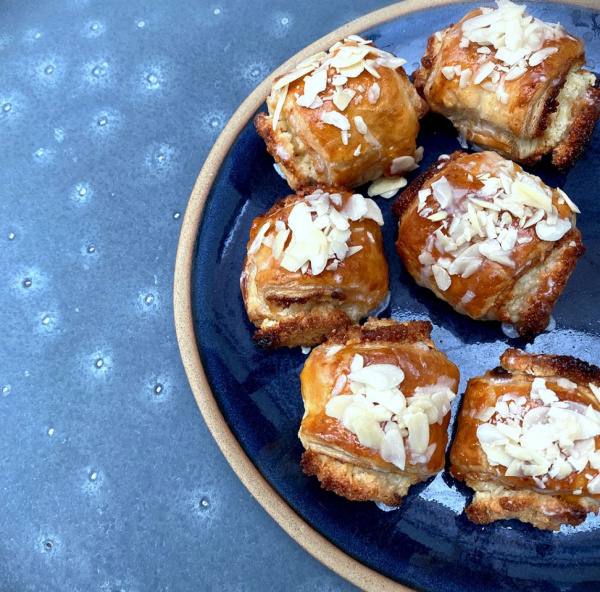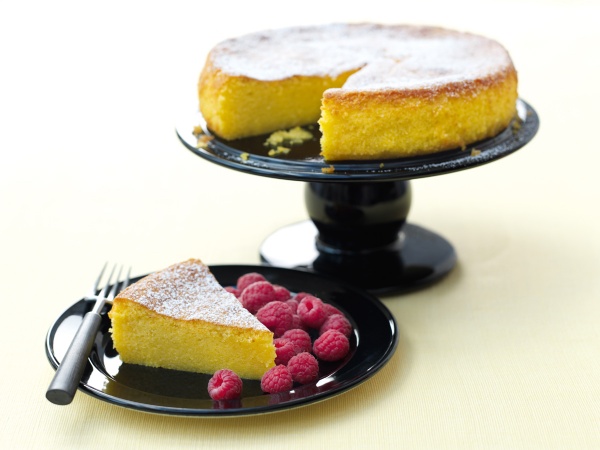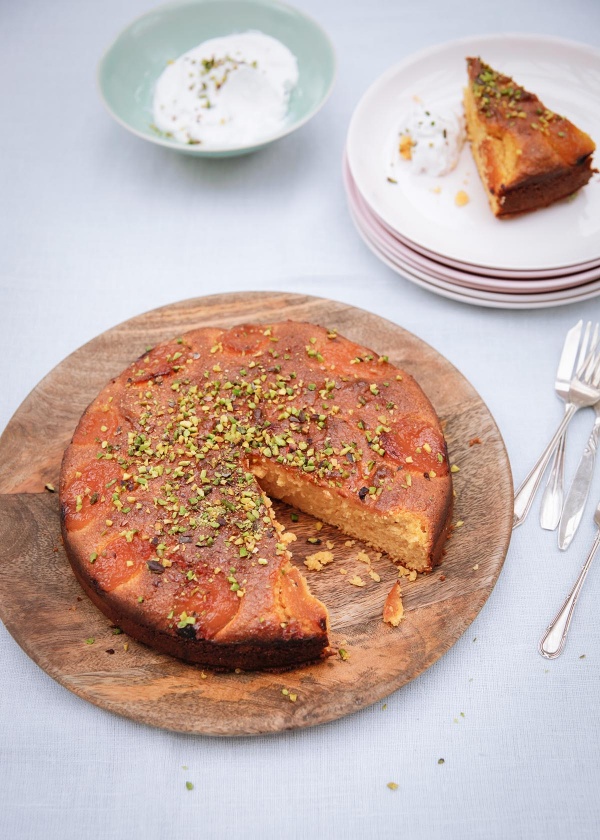Banket Bars
by NigellaIntroduction
It can be hard to adopt other countries’ Christmas traditions and cherish them like our own, but when it comes to this Dutch log of almond paste, encased in puff pastry, I have no problem whatsoever!
Rather than make long logs (or, indeed wreathes or letters, as they do in the Netherlands) I cut them into short lengths before baking, which rather gives them a look of sweet sausage rolls. They should, in this form, a Dutch friend tells me, more properly be called banketstaafstukjes, though I’ve settled on Banket Bars instead. They make a great alternative to mince pies for those who shudder at the very idea of dried fruit, and a most desirable addition for the rest of us.
They are reassuringly easy to rustle up. No need to make your own puff pastry, but you do need to make your own almond paste. However, it’s not hard to make almond paste: in a processor it’s the work of lazy minutes. (And by the way, almond paste and marzipan are not quite the same thing.) The only thing you need to remember is to make it a day (or up to 3 days) before you go a-baking, but since the puff pastry is best thawed for a day in the fridge, too, you can have both in the fridge ready and waiting for you at the same time.
And please read the Additional Information section at the end of the recipe before proceeding.
For US cup measures, use the toggle at the top of the ingredients list.
It can be hard to adopt other countries’ Christmas traditions and cherish them like our own, but when it comes to this Dutch log of almond paste, encased in puff pastry, I have no problem whatsoever!
Rather than make long logs (or, indeed wreathes or letters, as they do in the Netherlands) I cut them into short lengths before baking, which rather gives them a look of sweet sausage rolls. They should, in this form, a Dutch friend tells me, more properly be called banketstaafstukjes, though I’ve settled on Banket Bars instead. They make a great alternative to mince pies for those who shudder at the very idea of dried fruit, and a most desirable addition for the rest of us.
They are reassuringly easy to rustle up. No need to make your own puff pastry, but you do need to make your own almond paste. However, it’s not hard to make almond paste: in a processor it’s the work of lazy minutes. (And by the way, almond paste and marzipan are not quite the same thing.) The only thing you need to remember is to make it a day (or up to 3 days) before you go a-baking, but since the puff pastry is best thawed for a day in the fridge, too, you can have both in the fridge ready and waiting for you at the same time.
And please read the Additional Information section at the end of the recipe before proceeding.
For US cup measures, use the toggle at the top of the ingredients list.

Share or save this
Ingredients
Makes: 16
TO MAKE THE ALMOND PASTE FILLING (to be done a day before the baking of the Banket Bars)
- 250 grams blanched almonds
- 250 grams caster sugar
- finely grated zest of an unwaxed lemon (you’ll need the juice for the glaze)
- ⅛ teaspoon / drop or two of rosewater
- ¼ teaspoon fine sea salt
- 1 large egg
TO MAKE THE BANKET BARS
- 1 large egg
- pinch of salt
- 325 or 320 grams ready-rolled all-butter frozen puff pastry (which has been thawed overnight in the fridge)
- 2 x 270 grams logs of almond paste
FOR THE APRICOT GLAZE
- 2 tablespoons apricot jam
- 1 teaspoon lemon juice
- 30 grams flaked almonds
FOR THE ICING GLAZE
- 60 grams icing sugar
- 1 tablespoon lemon juice (or as needed to make a runny icing to zig zag over the banket bars)
TO MAKE THE ALMOND PASTE FILLING (to be done a day before the baking of the Banket Bars)
- 2 cups skinned almonds
- 1¼ cups granulated sugar
- finely grated zest of an unwaxed lemon (you’ll need the juice for the glaze)
- ⅛ teaspoon / drop or two of rosewater
- ¼ teaspoon fine sea salt
- 1 large egg
TO MAKE THE BANKET BARS
- 1 large egg
- pinch of salt
- 11 ounces ready-rolled all-butter frozen puff pastry (which has been thawed overnight in the fridge)
- 2 x 10 ounces logs of almond paste
FOR THE APRICOT GLAZE
- 2 tablespoons apricot jam
- 1 teaspoon lemon juice
- ⅓ cup sliced almonds
FOR THE ICING GLAZE
- ⅔ cup confectioners' sugar
- 1 tablespoon lemon juice (or as needed to make a runny icing to zig zag over the banket bars)
Method
- Before you start, tear off a piece of baking parchment about 45cm/17inches long and place it on the kitchen counter with the short side facing you (conveniently, most baking parchments are 38cm/15inches in width, which is moreorless exactly how long you want each log to be) and sit a jar or canister on the far end to help stop it curling back on itself.
- Clatter the blanched almonds into the bowl of a processor, add the sugar, and process until finely ground. Starting off with whole almonds rather than ready ground makes for a much more luscious texture. And adding the sugar along with the almonds stops them from forming an oily clump on mixing.
- Once the nuts are ground, add the lemon zest, rosewater and salt, crack in the egg, and blitz again until the mixture forms a thick but lightly perfumed grainy paste in the processor bowl.
- Tip out and squodge the sticky mixture together with your hands, before dividing into two pieces. (And I actually weigh the paste for this, so I can make sure I have exactly the same amount for each log; there may well be some small deviation, but I find I generally end up with two clumps of slightly gritty paste of around 270g/10oz each.) Sit one of the pieces on the baking parchment and, with your hands, form into a rough sausage shape pretty much the width of the baking parchment, but don’t worry about it being particularly even at this stage.
- Place this clumpy almond-paste sausage, not worrying about cracks, horizontally on the baking parchment, about 5cm/2inches from the bottom. Cover it with the bit of parchment closest to you. Then, as if it were a rolling pin, place the flat of your hands gently over it and roll up and down, moving your hands as needed to help you get an even shape, until you have a fairly slender log — around 3cm/1¼inches diameter or a whisper under — of almond paste which pretty much comes to each end of the parchment. Wrap this covered log with the rest of the parchment it’s sitting on, as a first layer, then wrap well with clingfilm, as you don’t want this tender, fragrant paste to dry out, then pop into the fridge until needed, where it can stay for up to 3 days. And then repeat exactly the same process for the second piece of almond paste. The day before you plan to turn these lengths of almond paste into Banket Bars, take the puff pastry out of the freezer and put it in the fridge to thaw.
- When you want to bake them, heat the oven to 220ºC/200ºC Fan/425ºF and line a flat baking sheet with parchment.
- Crack the egg into a cup or little jug, add the salt and whisk to make an egg wash, setting aside for now, although you might as well get a pastry brush (I much prefer a silicon pastry brush to a bristle one) at the same time.
- Take the thawed puff pastry straight from the fridge — you don’t want it sitting around in the kitchen as the warmer it gets, the stickier it becomes. Unroll it from its packaging, cut it in half lengthways and pop one of the halves back in the fridge, taking one of the almond paste logs out at the same time.
- Should you have a silicone rolling mat, place the rectangular piece of puff pastry horizontally on it; otherwise, dust a clean, flat surface lightly with flour. Unroll the almond paste log from its wrapping and lie it, also horizontally, in the middle of the puff-pastry sheet; the long sausage of almond paste should pretty much go right to the ends of the puff pastry.
- Paint the exposed surface of puff pastry either side of the almond paste with the egg wash, and then tenderly pick up the far side of the egg-washed pastry and cover the almond paste log with it, then roll it towards you so that it’s covered in the pastry. Press the seam in gently with your fingers to stick it down and smooth it, and cut away any excess pastry from the ends, so that the paste and pastry are flush, and leave the long log seam side down.
- With a sharp and preferably serrated knife, cut this long log into 8 pieces. I do this by cutting the log first in half, then in half again, and so on until I have 8 moreorless equal rolls. If you want to get a ruler out instead, by all means do so: some of us feel reassured by ultra-precision and some of us are irritated by it; you should do whatever makes you happier! Place the rolls carefully seam-side down onto your lined flat baking sheet and paint with egg wash, then pop the tray into the hot oven to bake for 15 minutes by which time they should be plump and puffy — who isn’t at Christmas? — and golden on top.
- Slide the paper off with the little banket bars on it onto a wire cooling rack or just straight onto the kitchen counter. Some of the almond paste may have popped out of the pastry at the ends, with a little char at the edges, but just squeeze them back in. I have asbestos hands, so just use my fingers, but it would be wiser to use a couple of spoons or other implements of your choice. And I should say that one of the reasons I like to cut the banketstaaf into short lengths before baking, is that this way the almond paste at each end slightly scorches, taking on the taste and texture of deeply caramelly marzipan.
- While the Banket Bars are cooking, mix the apricot jam and lemon juice together in one little bowl (removing any pieces of apricot) and have the flaked almonds ready in another. In yet another little bowl, whisk the icing sugar with a 15ml tablespoon of lemon juice or as much as needed to give you a thick but still flowing icing. This icing isn’t a universal feature of banketstaaf, but its bright sharpness adds an enlivening zing, and who doesn’t want that?
- As soon as the Banket Bars have come out of the oven, had the ends pressed in and have been slipped off the baking sheet, paint them immediately with the apricot jam and lemon mixture, then sprinkle each roll with about half a teaspoon of flaked almonds. Finally, using a teaspoon (and I favour one with a rather pointy end) zig zag each Banket Bar with some of the lemony icing, and leave on the baking parchment to cool.
- Continue with the second batch, though you may want to add a little more lemon juice to the icing, as it tends to thicken on standing.
- Before you start, tear off a piece of baking parchment about 45cm/17inches long and place it on the kitchen counter with the short side facing you (conveniently, most baking parchments are 38cm/15inches in width, which is moreorless exactly how long you want each log to be) and sit a jar or canister on the far end to help stop it curling back on itself.
- Clatter the skinned almonds into the bowl of a processor, add the sugar, and process until finely ground. Starting off with whole almonds rather than ready ground makes for a much more luscious texture. And adding the sugar along with the almonds stops them from forming an oily clump on mixing.
- Once the nuts are ground, add the lemon zest, rosewater and salt, crack in the egg, and blitz again until the mixture forms a thick but lightly perfumed grainy paste in the processor bowl.
- Tip out and squodge the sticky mixture together with your hands, before dividing into two pieces. (And I actually weigh the paste for this, so I can make sure I have exactly the same amount for each log; there may well be some small deviation, but I find I generally end up with two clumps of slightly gritty paste of around 270g/10oz each.) Sit one of the pieces on the baking parchment and, with your hands, form into a rough sausage shape pretty much the width of the baking parchment, but don’t worry about it being particularly even at this stage.
- Place this clumpy almond-paste sausage, not worrying about cracks, horizontally on the baking parchment, about 5cm/2inches from the bottom. Cover it with the bit of parchment closest to you. Then, as if it were a rolling pin, place the flat of your hands gently over it and roll up and down, moving your hands as needed to help you get an even shape, until you have a fairly slender log — around 3cm/1¼inches diameter or a whisper under — of almond paste which pretty much comes to each end of the parchment. Wrap this covered log with the rest of the parchment it’s sitting on, as a first layer, then wrap well with clingfilm, as you don’t want this tender, fragrant paste to dry out, then pop into the fridge until needed, where it can stay for up to 3 days. And then repeat exactly the same process for the second piece of almond paste. The day before you plan to turn these lengths of almond paste into Banket Bars, take the puff pastry out of the freezer and put it in the fridge to thaw.
- When you want to bake them, heat the oven to 220ºC/200ºC Fan/425ºF and line a flat baking sheet with parchment.
- Crack the egg into a cup or little jug, add the salt and whisk to make an egg wash, setting aside for now, although you might as well get a pastry brush (I much prefer a silicon pastry brush to a bristle one) at the same time.
- Take the thawed puff pastry straight from the fridge — you don’t want it sitting around in the kitchen as the warmer it gets, the stickier it becomes. Unroll it from its packaging, cut it in half lengthways and pop one of the halves back in the fridge, taking one of the almond paste logs out at the same time.
- Should you have a silicone rolling mat, place the rectangular piece of puff pastry horizontally on it; otherwise, dust a clean, flat surface lightly with flour. Unroll the almond paste log from its wrapping and lie it, also horizontally, in the middle of the puff-pastry sheet; the long sausage of almond paste should pretty much go right to the ends of the puff pastry.
- Paint the exposed surface of puff pastry either side of the almond paste with the egg wash, and then tenderly pick up the far side of the egg-washed pastry and cover the almond paste log with it, then roll it towards you so that it’s covered in the pastry. Press the seam in gently with your fingers to stick it down and smooth it, and cut away any excess pastry from the ends, so that the paste and pastry are flush, and leave the long log seam side down.
- With a sharp and preferably serrated knife, cut this long log into 8 pieces. I do this by cutting the log first in half, then in half again, and so on until I have 8 moreorless equal rolls. If you want to get a ruler out instead, by all means do so: some of us feel reassured by ultra-precision and some of us are irritated by it; you should do whatever makes you happier! Place the rolls carefully seam-side down onto your lined flat baking sheet and paint with egg wash, then pop the tray into the hot oven to bake for 15 minutes by which time they should be plump and puffy — who isn’t at Christmas? — and golden on top.
- Slide the paper off with the little banket bars on it onto a wire cooling rack or just straight onto the kitchen counter. Some of the almond paste may have popped out of the pastry at the ends, with a little char at the edges, but just squeeze them back in. I have asbestos hands, so just use my fingers, but it would be wiser to use a couple of spoons or other implements of your choice. And I should say that one of the reasons I like to cut the banketstaaf into short lengths before baking, is that this way the almond paste at each end slightly scorches, taking on the taste and texture of deeply caramelly marzipan.
- While the Banket Bars are cooking, mix the apricot jam and lemon juice together in one little bowl (removing any pieces of apricot) and have the sliced almonds ready in another. In yet another little bowl, whisk the confectioners' sugar with a 15ml tablespoon of lemon juice or as much as needed to give you a thick but still flowing icing. This icing isn’t a universal feature of banketstaaf, but its bright sharpness adds an enlivening zing, and who doesn’t want that?
- As soon as the Banket Bars have come out of the oven, had the ends pressed in and have been slipped off the baking sheet, paint them immediately with the apricot jam and lemon mixture, then sprinkle each roll with about half a teaspoon of sliced almonds. Finally, using a teaspoon (and I favour one with a rather pointy end) zig zag each Banket Bar with some of the lemony icing, and leave on the baking parchment to cool.
- Continue with the second batch, though you may want to add a little more lemon juice to the icing, as it tends to thicken on standing.
Additional Information
In the UK, ready-rolled puff pastry sheets tend to be between 35 and 40cm wide. If the width of your sheets is smaller, cut your almond paste logs to fit.
MAKE AHEAD:
The almond paste can be made ahead. Keep the tightly wrapped logs in the fridge for up to 3 days.
FREEZE:
The almond paste logs can also be frozen. Wrap the parchment-covered logs tightly with a double layer of foil and freeze for up to 3 months. Defrost the almond paste logs for 12-24 hours in the fridge with the puff pastry.
STORE:
The Banket Bars are at their best on the day of making. Leftovers can be stored in an airtight container in a cool place for a day or two.
In the UK, ready-rolled puff pastry sheets tend to be between 35 and 40cm wide. If the width of your sheets is smaller, cut your almond paste logs to fit.
MAKE AHEAD:
The almond paste can be made ahead. Keep the tightly wrapped logs in the fridge for up to 3 days.
FREEZE:
The almond paste logs can also be frozen. Wrap the parchment-covered logs tightly with a double layer of foil and freeze for up to 3 months. Defrost the almond paste logs for 12-24 hours in the fridge with the puff pastry.
STORE:
The Banket Bars are at their best on the day of making. Leftovers can be stored in an airtight container in a cool place for a day or two.




Tell us what you think
Thank you {% member.data['first-name'] %}.
Explore more recipesYour comment has been submitted.